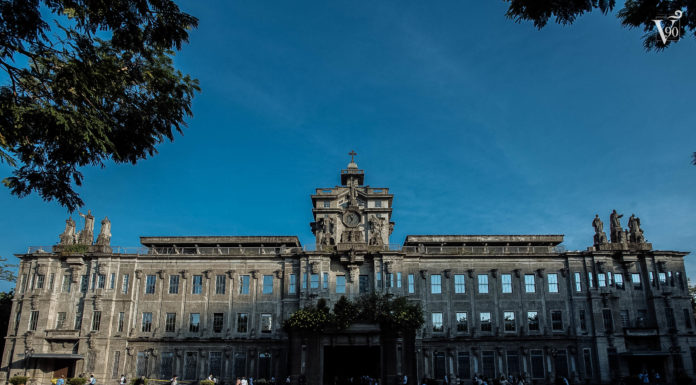A NEOCLASSIC stone façade with lime-based plaster used to greet churchgoers to the Immaculate Conception Cathedral in Pasig. Inside was a well-preserved baptistery with its blue azulejo tile flooring and its altar adorned by a painting of the baptism of Jesus Christ.
But the baptistery had seen better days. It stood decrepit and worn until a team of restorers worked on it for several months to revive its old beauty but with a new sheen.
The credit for the almost-heavenly restoration goes to Thomasians from the UST Center for Conservation of Cultural Property and Environment in the Tropics (CCCPET). They restored the 245-year-old façade of the cathedral and its equally enduring 138-year-old baptistery.
For seven months, UST Cultural Heritage professor Maita Reyes, Beato Angelico Gallery curator Mary Ann Venturina-Bulanadi, University of Northern Philippines professor Oliver Rabara and architect Michael Manalo of UST-CCCPET worked to bring back the cathedral’s elegance in time for the dedication last Dec. 7, on the eve of the Immaculate Conception feast day. The same group restored in 2005 the bas relief of the Our Lady of the Apocalypse in the east nave of the church built around 1762.
Fr. Roy Rosales, chancellor and rector of the cathedral, said that the restoration of the façade would not have been necessary had he not seen signs that the cement from the portico of the church was chipping off in 2005, which made it unsafe for people passing by the cathedral.
The chairman of the Pasig Diocesan Commission for the Cultural Heritage of the Church, Rosales ordered the removal of the cement from the façade and its replacement with the original lime-based plaster during the restoration that started on March 2006.
“Instead of using plaster cement, we used toughened lime, which is the original material used in the construction of the church,” Rosales told the Varsitarian. He commissioned Manalo, a 1998 UST Architecture graduate, to manage the restoration.
Pasigueños’ heritage
The cathedral’s baptistery, according to Rosales, is unique in the country.
“The baptistery was built in 1869. Unlike other churches where the baptistery is built within the church, ours was built as an attachment to the cathedral,” he said.
Rosales added that the cathedral’s baptistery has retained much of its original elements since its construction.
“The baptismal font in the baptistery is the original font used since 1867, even before the baptistery was built. The blue azulejo tiles, representing water and life, are the only original tiles remaining in the church,” he said.
According to Rosales, who earned his Philosophy degree at the UST Central Seminary in 1977 and his Masteral degree in Cultural Heritage at the UST Graduate School in 2001, the baptistery’s retablo was baroque-inspired. Meanwhile, the altar piece, a painting of the Baptism of Jesus Christ, was a masterpiece of lawyer Leandro Jabson in 1912. This was complemented by a stained-glass window on the left side of the baptistery, also showing Jesus’ baptism, made by Thomasian artist and teacher Cenon Rivera in 1984.
“The baptistery’s relative isolation protected it from the ruthless modernization of the ‘60’s which the rest of the church and convent fell prey to,” Rosales said. “Despite this, Jabson’s painting was stored in a damp bodega of the rectory, exposed to the elements until the present restoration.”
Rosales commissioned 1979 UST Chemistry graduate Maita Reyes to restore the baptistery’s tiles and the painting. Reyes, a former restorer of the Manila Archdiocesan Archives and of the Lopez Memorial Museum, invited Bulanadi, a 1986 Architecture graduate, together with Rabara, an Advertising alumnus, to work with her in restoring the baptistery. The three worked on the restoration of the Our Lady of Apocalypse, which was re-enthroned on the east nave opposite the gates to the baptistery in September 2005.
Reyes explained that the baptistery was built directly into the soil, with no concrete flooring underneath, with the tiles deteriorating due to constant trampling. The painting likewise endured a terrible condition. Reyes said the paint was flaking off, the canvas was brittle, and there were cracks and molds in the painting.
She also noticed the presence of acids destroying the canvas, which they later found out to be coming from plywood attached to the back of the painting. The acids cut the fibers of the cloth, making it weak.
The team removed the painting from the stretcher and covered it in a special Japanese tissue for transport to the San Agustin Museum in Manila where the restoration was done. The painting was first cleaned, and then tested to determine the right chemical and physical stabilizers to be used. Then, the painting was “cured” of its ailments.
The tiles also underwent the same restoration procedure as that used in the painting. However, since the tiles sit on soil, the restoration was done on site.
The team also replaced badly damaged tiles with newly fabricated ones but customized to the design of the old tiles. After aesthetic unity was established, the team applied a special porous protective coating to the tiles, allowing the soil underneath to “breathe.”
Ongoing
Rosales said that restoration work in his parish and in the Pasig diocese will continue.
“If the façade had not chipped off, we would not be aware of the limestones underneath that were disintegrating,” Rosales said, adding that even the minor altars of the cathedral are in need of restoration because of the presence of termites.
Aside from the cathedral, Rosales also oversees the centuries-old parishes of St. Anne in Taguig and San Roque in Pateros. For him, as well as the group, the cultural heritage of the Catholic Church should be preserved, as churches, relics, statues and other artworks serve as reminders of the endurance and legacy of the Catholic faith.
“We have to keep these things because they are part of history. They are not mere displays, but are evangelical tools used to teach people about the Catholic faith,” Rosales said. Nathaniel R. Melican















